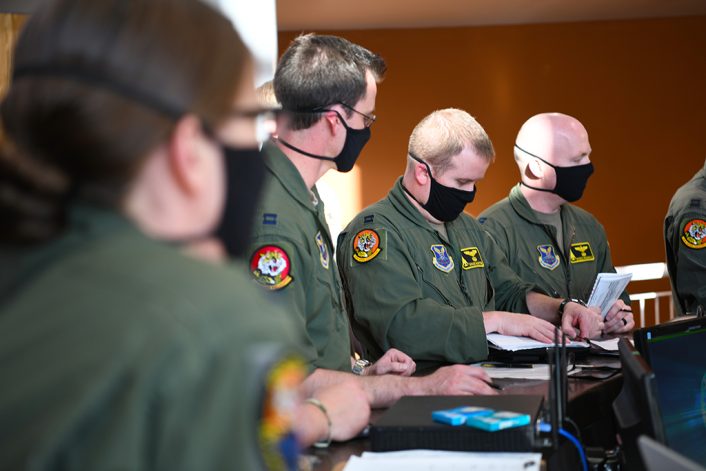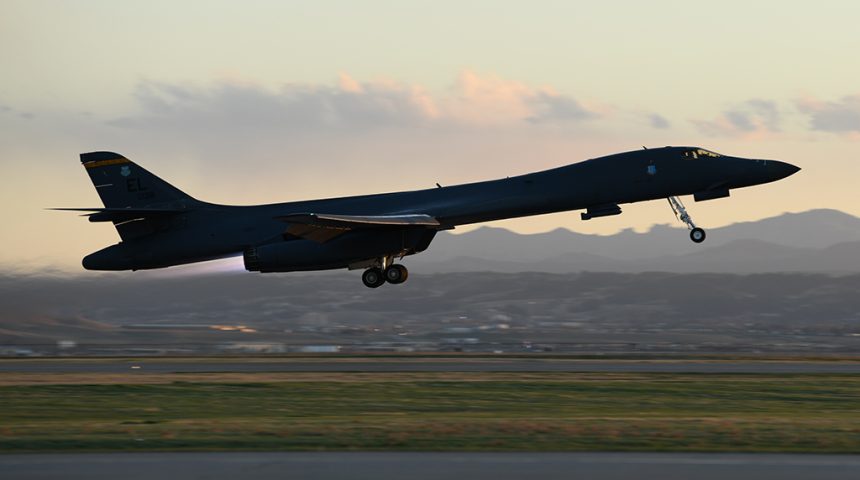The BONEs launched from Ellsworth Air Force Base, South Dakota.
Two U.S. Air Force B-1B Lancers (or “BONEs” from B-One, as the bombers are dubbed) belonging to the 28th Bomb Wing, Ellsworth AFB, S.D., conducted an extended deterrence 32-hour round-trip sortie over the South China Sea on April 29, 2020.
According to the Pacific Command, the mission was carried out as part of a joint U.S. Indo-Pacific Command and U.S. Strategic Command (USSTRATCOM) Bomber Task Force (BTF) mission.
“This operation demonstrates the U.S. Air Force’s dynamic force employment model in line with the National Defense Strategy’s objectives of strategic predictability with persistent bomber presence, assuring allies and partners,” says an official statement released after the mission.
The mission follows a bilateral training where the Ellsworth’s B-1s departed from their homebase integrated with six U.S. Air Force F-16s and 15 Koku Jieitai (Japan Air Self-Defense Force) F-15s near Japan and returned back home after a nearly 29-hour mission.
As a side note, crew members are shown wearing masks introduced after the Covid-19 pandemic outbreak.

“USSTRATCOM has conducted BTF missions (previously known as Bomber Assurance and Deterrence missions) since 2014 as a demonstration of the U.S. commitment to collective security, and to integrate with Geographic Combatant Command operations. The first mission included B-52H Stratofortresses and B-2 Spirits traveling from the continental United States to Joint Base Pearl-Harbor Hickam in April 2014.”
Although such round-trip missions, once dubbed “Global Reach” missions, have been carried out from CONUS (Continental US) every now and then employing both nuclear capable B-52s and B-2s, as well as supersonic B-1 bombers, it’s at least worth noticing that the frequency of these sorties has increased in the last period, likely as a consequence of the end of the “on-site” rotations of bombers to Guam. Indeed, the USAF has recently completed its last CBP (Continuous Bomber Presence) mission that has been ongoing since 2004 to Andersen Air Force Base; an event that was marked with a final “Elephant Walk” readiness exercise that involved, along with the five B-52s deployed from Minot Air Force Base, North Dakota, also 6x KC-135 tankers, a USAF RQ-4B Global Hawk drone as well as one of the two U.S. Navy MQ-4C Triton that have recently started operating out of the military outpost in the Pacific.
The transition to an employment model that sees the bombers operate in the Indo-Pacific region from their stateside bases is in line with the National Defense Strategy’s objectives of strategic predictability and operational unpredictability. In other words, instead of deploying bombers on 6-month rotations to Guam, the Air Force will leverage CONUS and overseas bases (including Guam, if needed) to project the air power to the Pacifc in a more unpredictable way. In this way, regional opponents, such as China and Russia, can’t directly target and disable a bomber force that is not within reach.
“The rapid employment of airpower directly supports the National Defense Strategy and assures we can provide overwhelming force anywhere, anytime in support of American interests or our Allies and partners,” said Gen. Tim Ray, Air Force Global Strike Command and Air Forces-Strategic commander in a public statement issued on Apr. 22. “This mission [the 29-hour round-trip sortie where it integrated with the Japan Air Self Defense Force (JASDF) in the Pacific Air Forces (PACAF) area of responsibility] is a demonstration to our friends throughout the region: we will continue to remain fully predictable in our commitment to ensuring peace, while also demonstrating that we have the ability to operate from numerous locations across the globe, even during the global pandemic.”
Interestingly, the last time the B-1 was in the INDOPACOM AOR was during the last B-1’s Continuous Bomber Presence mission at Andersen Air Force Base, Guam in January 2018. The B-1B had started deploying from Ellsworth AFB, South Dakota, on Aug. 6, 2016, as part of their first CBP deployment in support of the U.S. Pacific Command’s (USPACOM) deterrence efforts in the Indo-Asia-Pacific region in 10 years. During their deployment to Guam the B-1s belonging to the 37th EBS and then the 9th Expeditionary Bomb Squadron from Dyess AFB, Texas, conducted a variety of joint and bilateral training missions with the U.S. Navy, U.S. Marine Corps, Japan Air Self-Defense Force, South Korean air force and Royal Australian Air Force, including some symbolic shows of force against North Korea alongside the U.S. Marine Corps F-35B forward based in Japan.









